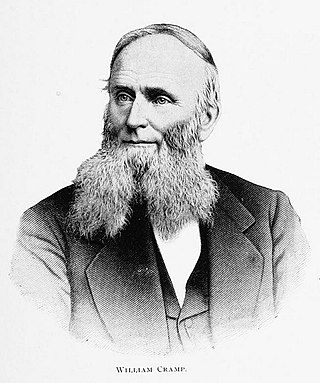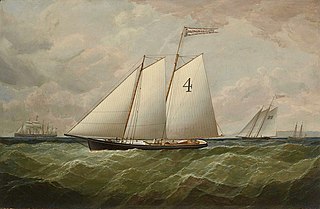
William Cramp & Sons Shipbuilding Company of Philadelphia was founded in 1830 by William Cramp, and was the preeminent U.S. iron shipbuilder of the late 19th century.

City Ice Boat No. 3, commonly known as Ice Boat No. 3 or just No. 3, was a municipal sidewheel icebreaker built in 1873 to assist in keeping Philadelphia's waterways free of ice during the winter months. The vessel was also used for occasional excursions and other duties through the rest of the year.

The Edward C. Knight, also known as the E. C. Knight, was a 19th-century pilot boat built by the C. & R. Poillon shipyard in 1875 for the Delaware River Pilots. She was the finest and fastest pilot-boat belonging to the Philadelphia port. She was sold to the Brunswick Pilots' Association of Georgia in 1898.

The Varuna was a 19th-century Boston pilot boat, built by Montgomery & Howard at Chelsea, Massachusetts in 1890, for a group of Boston pilots. She was designed by yacht designer Edward Burgess, known for his America's Cup defenders. She was the first centerboard pilot-boat in operation in the Massachusetts Bay. The Varuna went out of service in 1912 because of the introduction of steam power into pilot-boats. She was later sold to Stephen Simmons to be used as a trading vessel between ports in the Spanish Main in 1913.

The Christian Bergh was a 19th-century Sandy Hook pilot boat built in 1851 at the Westervelt & Co. shipyard. She later became a Pennsylvania pilot boat until her service ended in 1886 when she became an oyster boat in the Delaware Bay. She was named after Christian Bergh a prominent shipbuilder in New York and a close friend of Jacob Westervelt.

The Edward E. Barrett, or Edward E. Bartlett, was a 19th-century two-masted Sandy Hook pilot boat, built by C. & R. Poillon in 1883 and designed by William Townsend. She helped transport New Jersey maritime pilots between inbound or outbound ships coming into the New York Harbor. She was one of the pilot boats that survived the Great Blizzard of 1888. In the age of steam, the Barrett ended her pilot commission and was sold in 1904.

The David Carll was a 19th-century pilot boat, built in 1885 at the David Carll shipyard in City Island, New York. She was named in honor of David Carll, a well-known City Island shipbuilder. The David Carll was considered to be among the fastest schooners in the fleet. She was built to replace the Mary E. Fish that was run down and sank by the schooner Frank Harrington in 1885. She was one of the pilot boats that survived the Great Blizzard of 1888. The David Carll was lost at sea in 1893.

The Abraham Leggett was a 19th-century New York pilot boat built by Daniel Westervelt at the Westervelt & Co. shipyard. She helped transport New York City maritime pilots between inbound or outbound ships coming into the New York Harbor. In 1866, Pilot Michael Murphy was on the Abraham Leggett when the bark Emilie ran into the pilot boat. In 1879, the Abraham Leggett was hit and sank by the steamship Naples from Liverpool. She was replaced by the pilot boat Alexander M. Lawrence.
The James Gordon Bennett was a 19th-century two-masted pilot boat, built in 1870 at the Lawrence & Foulks shipyard. She was named in honor of James Gordon Bennett, Jr., publisher of the New York Herald. She went ashore in 1893 and was rebuilt at the C. & R. Poillon shipyard. In 1897, the James Gordon Bennett was bought by Miller J. Morse of the Atlantic Yacht Club and made into a yacht. He changed her name to Hermit. The New Jersey pilots purchased her in 1901, to replace the David T. Leahy, that was run down by the steamship Alene. The Hermit sank in 1906, when the steamship Monterey ran into her.
The A. T. Stewart was a 19th-century Sandy Hook pilot boat built in 1865 at the Edward F. Williams shipyard to replace the pilot boat George Steers, which was lost in 1865. She was built for the New Jersey and New York Sandy Hook Pilots Association. The Stewart was in a collision with the steamship Scotia and sank in 1869. She was replaced by the James Gordon Bennett in 1870.

The Enchantress was a 19th-century Sandy Hook pilot boat built in 1851 by John Maginn who named her after one of the cast in the opera The Enchantress. She was launched from the Westervelt & McKay shipyard. The Enchantress was one of the oldest pilot-boats in the service. She was Cornelius Vanderbilt's favorite pilot boat. The Enchantress went down with all hands in the Great Blizzard of 1888. The pilot boat James Stafford was built to replace her.

Thomas D. Harrison was a 19th-century New York pilot boat built for New Jersey pilots. She was launched from the Jacob S. Ellis & Son shipyard, at Tottenville, Staten Island in 1875. The Harrison went ashore in the Great Blizzard of 1888 with no lives lost. She continued as a pilot boat with Pilot Stephen Cooper in command. She was purchased in 1897 by Allerton D. Hitch and used for coastal trade in the Cape Verde islands off the west African coast.

Gracie was a 19th-century Boston pilot boat built in 1869 at the Edward A. Costigan shipyard in Charlestown, Massachusetts. The schooner was used by Boston pilots and was sold to North Carolina pilots in 1881.
The Pilots' Association For The Bay & River Delaware is the official maritime pilot group for the Delaware Bay and Delaware River. The association is one of the oldest state pilot organizations in the nation that was founded in 1896. Delaware Bay Pilots are licensed maritime pilots for the Delaware Bay and River. Delaware pilots guide oceangoing vessels, passenger liners, freighters and tankers in and out of the harbor. The Delaware Bay is bordered inland by the States of New Jersey and Delaware, and the Delaware Capes, Cape Henlopen to the south and Cape May to the north, on the Atlantic Ocean.

The Thomas F. Bayard was a 19th-century Delaware River pilot schooner built by C. & R. Poillon shipyard in 1880. She spent sixteen years as a pilot boat before being sold during the Yukon Gold Rush in 1897. She was sold again in 1906 for Seal hunting, then purchased by the Department of Marine & Fisheries where she guided freighters into New Westminster, British Columbia for 43 years. She was then acquired by the Vancouver Maritime Museum in 1978. When she sank at her mooring in 2002, the International Yacht Restoration School, Mystic Seaport and the Vancouver Maritime Museum, removed the vessel in pieces for the archeological teams to study and document the remains of her hull. The Thomas F. Bayard Collection, at the Vancouver Maritime Museum, contains the documents, history and preservation efforts.

The John G. Whilldin was a 19th-century Pennsylvania pilot schooner built in 1839 by the Joseph Vogle shipyard of Southwark, Philadelphia. In 1893, the Board of Port Wardens of Philadelphia recognized only four pilot boats for the Port of Philadelphia, the E. C. Knight, John G. Whilldin,William W. Ker and J. Henry Edmunds. On September 8, 1915, the Whilldin was reported as wrecked near Port St. Joe, Florida.

The Enoch Turley was a 19th-century Pennsylvania pilot schooner built in 1842 in Baltimore, Maryland. In the 1880s she was caught up in the competition and rivalry between New Jersey and Pennsylvania pilots and the Delaware pilots. She survived the Great Blizzard of 1888, but was swept away in 1889, with all hands lost, during a powerful gale.

The William W. Ker was a 19th-century Pennsylvania pilot schooner built in 1889 in Wilmington, Delaware. She was designed by Edward Burgess for the Pennsylvania pilots and was built for speed. She was a favorite with the pilots and was considered the fastest pilot boat on the coast. The Ker was hit and sank by a steamer off the Five Fathom Bank in 1900.

The Ebe W. Tunnell was a 19th-century Delaware pilot schooner built in 1887 in Brooklyn, New York. In 1889, the Tunnell was driven out to sea in a fierce storm. The crew spent five days in turbulent waters before they were rescued. In the age of steam, Ebe W. Tunnell had outlived its usefulness and was sold as a houseboat for a group of men working in the Chesapeake Bay in 1909.

The J. Henry Edmunds was a 19th-century pilot schooner built in 1887 in Brooklyn, New York for Philadelphia pilots. She sank in 1892 and a second Edmunds was built in 1893, which lasted thirty-five years before she sank in bad weather outside Cape Henlopen in 1928. She was the last schooner-rigged pilot boat in the Delaware Bay.

















